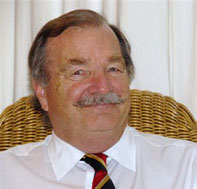Some may wonder how it was that I became P*A*T*R*O*L L*E*A*D*E*R of the Yellow Six (not that titles mean much to me) 0r, more formally, of the Peewit Patrol of the 1st Streetly Boy Scout in the county of Warwickshire for Yellow Six is a term more applicable to Wolf Cubs (junior boy scouts).
We were indeed real Boy Scouts with pointy hats and incredibly dangerous knives and we formed a complete patrol despite our low number. We remained only six because, well, nobody else would join us. I suppose the flies bothered them.
The ‘yellow’ label had to do with the yellow tabs we wore on our shirts. Each Scout patrol had an animal as a mascot and each animal was identified by a different colour tab. A green and black tab meant the Scouts were of the Eagle patrol whose members aspired to ‘soar like eagles’. This was a very casualty-prone patrol. The Beaver patrol resolved to ‘work hard’ and wore blue and yellow; the Wolf patrol, with its yellow and black was ‘true unto death’. There was a Hippo patrol but I was never sure what they aspired to do – presumably float around in swamps.
As each patrol crept about in the park, members would keep in touch by making noises appropriate to their chosen animal. The Wolf patrol howled and the Bulldog patrol barked; the Elephant patrol trumpeted while the Bat patrol went (according to the instructions in Baden-Powell’s s Scouting for Boys, ‘Pitz-pitz’. This was to mask one’s presence by fooling picnickers into assuming there were merely wolves passing through the park, or a small herd of elephants, or a flock of eagles, and people would carry on, oblivious, playing ball or picking ants out of their sandwiches.
My patrol was originally the Panther patrol which had yellow flashes. In Scouting for Boys the panther call is described as: ‘tongue inside of mouth – Keeook!’ We soon found that creeping around the park crying ‘Keeook!’ attracted unwanted attention and picnickers would sometimes call a park attendant or pack up their kids and go home.
The Elephant patrol had bigger problems. So did the Gannets so far from the sea, with their cry of ‘Aaarrr’. The Hyena patrol, which had to emit ‘a laughing cry – Ooowah-oowah-wah’, were sometimes set upon by whole families. After all, the last hyena to be seen in the English Midlands was in the late Pleistocene and older people obviously had unhappy memories of them.
Anyway, our panther cry of ‘Keeook’ didn’t sound very fierce so we changed to an animal whose sound was at least easy to mimic – the peewit. The peewit is a lapwing, a tall, crested bird. The call “peeee-wit”, startled but never frightened picnickers.
Our change from being the Jaguar patrol to the Peewit patrol was not the first time we had changed animal mascots. Originally we were the Woodpecker patrol whose official call was ‘heear flearfle’ which, we discovered, the British public was not yet ready for. The peewit’s colour tab was green and white. But as our mothers had already changed our tabs from woodpecker (red and white) to jaguar (yellow) they steadfastly refused to change tabs for a third time. So the peewits retained the yellow jaguar tabs – and hence the ‘yellow’ in the illustrious Yellow Six.
(I might tell you more later but it gets a bit sickening.)
You can pre-empt it all by rushing out and getting my book, The Yellow S ix, on kindle. But hurry while stocks last.
Filed under: Uncategorized | Leave a comment »




